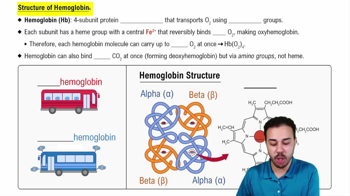Here are the essential concepts you must grasp in order to answer the question correctly.
Hematocrit
Hematocrit is the proportion of blood volume that is occupied by red blood cells (RBCs). It is expressed as a percentage and is a key indicator of blood's oxygen-carrying capacity. A high hematocrit suggests a higher concentration of RBCs, which can occur in conditions like dehydration or polycythemia.
Recommended video:
Hemoglobin
Hemoglobin is a protein found in red blood cells responsible for transporting oxygen from the lungs to the body's tissues and returning carbon dioxide from the tissues back to the lungs. The hemoglobin level is typically measured in grams per deciliter (g/dL) and is closely related to hematocrit, as more RBCs generally mean more hemoglobin.
Recommended video:
Relationship between Hematocrit and Hemoglobin
The relationship between hematocrit and hemoglobin is generally direct; as hematocrit increases, hemoglobin levels also tend to rise. This is because both measurements reflect the quantity of red blood cells in circulation. Therefore, if hematocrit is high, it is expected that hemoglobin levels would also be high, indicating a greater capacity for oxygen transport.
Recommended video:
 Verified step by step guidance
Verified step by step guidance


